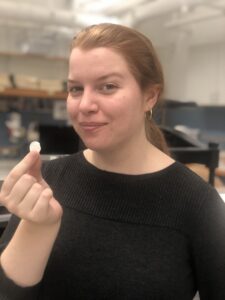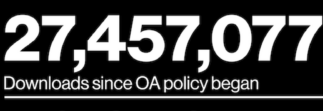 Ever since she heard about the painstaking, 21-year effort to conserve Leonardo da Vinci’s The Last Supper when she was in the eighth grade, Laura Bergemann ’19 has been fascinated by the conservation of artworks and other cultural objects. As a student worker in the MIT Libraries’ Wunsch Conservation Lab, the chemistry major has had the opportunity to practice various treatments, from repairing circulating books to caring for newly acquired indie tarot decks in the Libraries’ Distinctive Collections. Much of Bergemann’s time in the Lab, however, has been spent honing a skill you might not expect — espionage.
Ever since she heard about the painstaking, 21-year effort to conserve Leonardo da Vinci’s The Last Supper when she was in the eighth grade, Laura Bergemann ’19 has been fascinated by the conservation of artworks and other cultural objects. As a student worker in the MIT Libraries’ Wunsch Conservation Lab, the chemistry major has had the opportunity to practice various treatments, from repairing circulating books to caring for newly acquired indie tarot decks in the Libraries’ Distinctive Collections. Much of Bergemann’s time in the Lab, however, has been spent honing a skill you might not expect — espionage.
“I’ve been pretending to be a spy for a couple of years now,” she jokes.
These covert activities concern letterlocking, techniques that involve folding, cutting, and sealing messages written on paper and parchment. It is an area of research — developed by the Libraries’ Thomas F. Peterson Conservator, Jana Dambrogio, and Daniel Starza Smith of King’s College London — which offers insights into information security methods going back thousands of years. Squeezing in an hour or two here and there between classes, Bergemann has experimented with methods of “breaking in” to “locked” documents secured with historical techniques, by writing messages in invisible ink, creating forgeries of secret letters, and casting wax seals to create new seals. This work is part of the Lab’s ongoing collaboration with researcher Nadine Akkerman, who studies secret writing techniques and 17th-century women spies.
MIT history professors Jeffrey Ravel and Anne McCants helped introduce Bergemann and Dambrogio. The two first connected in the Netherlands while Bergemann was on a Palitz Fellowship. Dambrogio was there as part of the international interdisciplinary research team studying a trove of unopened letters from the 17th century for the Signed, Sealed, and Undelivered project. Bergemann contributed to the project by helping to verify letterlocking details found on the letters.
Back at MIT, Bergemann joined the Wunsch Lab to assist with conservation-related tasks and continue letterlocking research, including researching and translating a letter packet for an instructional video. Her work in the Lab has helped fuel her interest in conservation science, a field that draws from chemistry, physics, biology, and engineering to inform the analysis and care of cultural objects. It also adds to an already impressive resume that includes archaeological digs in Italy and Cypress and experience at Amsterdam’s Rijksmuseum analyzing 17th-century paint samples with a scanning electron microscope.
“I’ve had opportunities to be with some really special materials,” says Bergemann of her time at the MIT Libraries. After an archaeological dig in Israel this summer with MISTI, she will return to work part time at the Wunsch Lab in the fall. Bergemann says her hands-on experiences — whether working on a dig, in a lab, or in a museum — have given her valuable perspectives on objects at various points in their lifetime.
“The main thread throughout has been care for the object and a passion for history,” she says. “Who made it? Who had access to it? What does it mean now, and what did it mean to the people who had it originally?”
While she’s not leaving the Libraries just yet, Bergemann does have some parting wisdom for her fellow MIT students — don’t miss out on the Libraries and their “hidden gems” like the Wunsch Lab or the Beaver Press: “The Libraries are wonderful places to collaborate and do your work. They are places on campus that are actually designed with students and learning in mind.”

